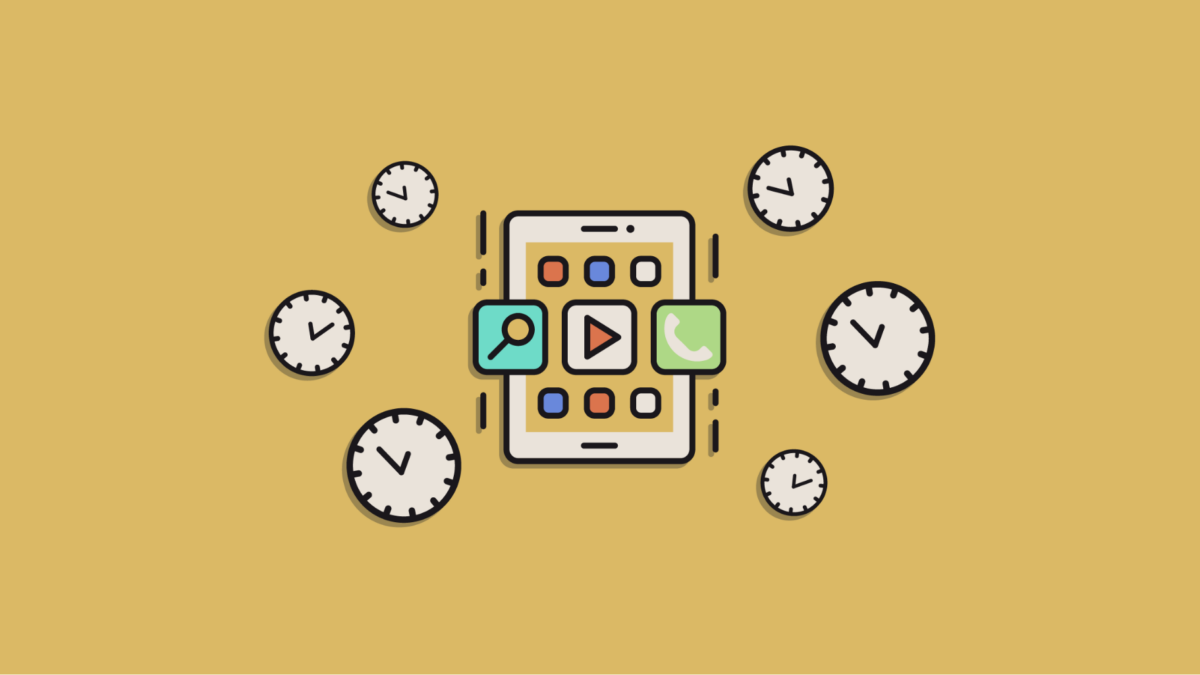
How long does it take to develop a mobile app? Here’s the short answer, and you’re going to hate us for this one: it depends.
The long answer? Well, keep reading.
What Factors Determine How Long it Will Take?
App development is not an overnight process, nor is it really ever done, hence the term development, not creation. It’s a long process that will vary depending on the size and dimension of the project. Some apps that are very simple can be done in a few weeks, and some can take months or even years to complete. The scope of the project, amount of features an app will have, budget, planning and preparation time, and the chosen development team are all factors that determine how long it will take to develop a mobile app.
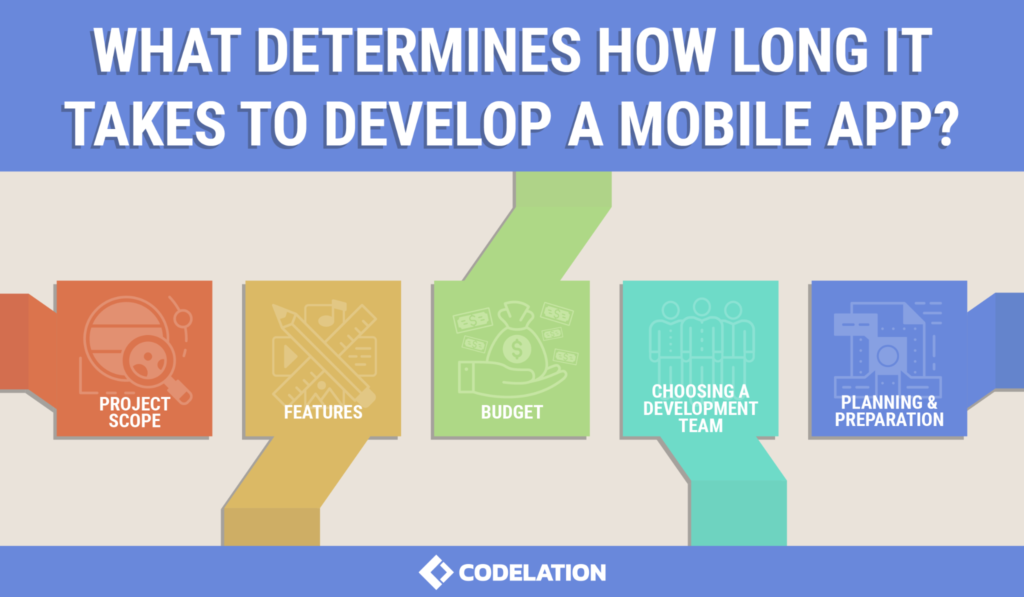
Project Scope
There are a few factors that determine the amount of time it will take to build an app. The first of which is project scope. Is the project going to be something that is built and launched? Or is it something that will need continual updates and changes? For example, a mobile app that is used to order food online would just need to be constructed and launched so that users could buy food. This type of build wouldn’t take too long once the app is constructed because it wouldn’t need constant updates unless the menu changes or a bug fix is needed. On the other hand, a mobile app build that's a game would need constant updates in order to push out new game content, keep users engaged, and fix bugs as they are discovered. These are two different types of projects with very different scopes, and thus would follow different timelines.
Features
Another thing that will affect the time it takes to build an app is how many features an app has. Apps that do multiple things will take longer to make than ones that have less features. This fact is a little more obvious than others, but it still needs to be said; if you want an app that does more, it takes longer than something more basic. And there is nothing wrong with more basic apps. They are sometimes the most cost effective way to start out rather than shooting big right away. It's totally normal to launch an app that is your minimum viable product (MVP) to gain supporters and raise more funds to build it bigger. Launching an MVP doesn't necessarily mean that you're launching the bare minimum of your product though. Here at Codelation, the MVP is determined by the product owner, so you get to decide what your minimum functionality, reliability, design, and usability are as the process moves along.
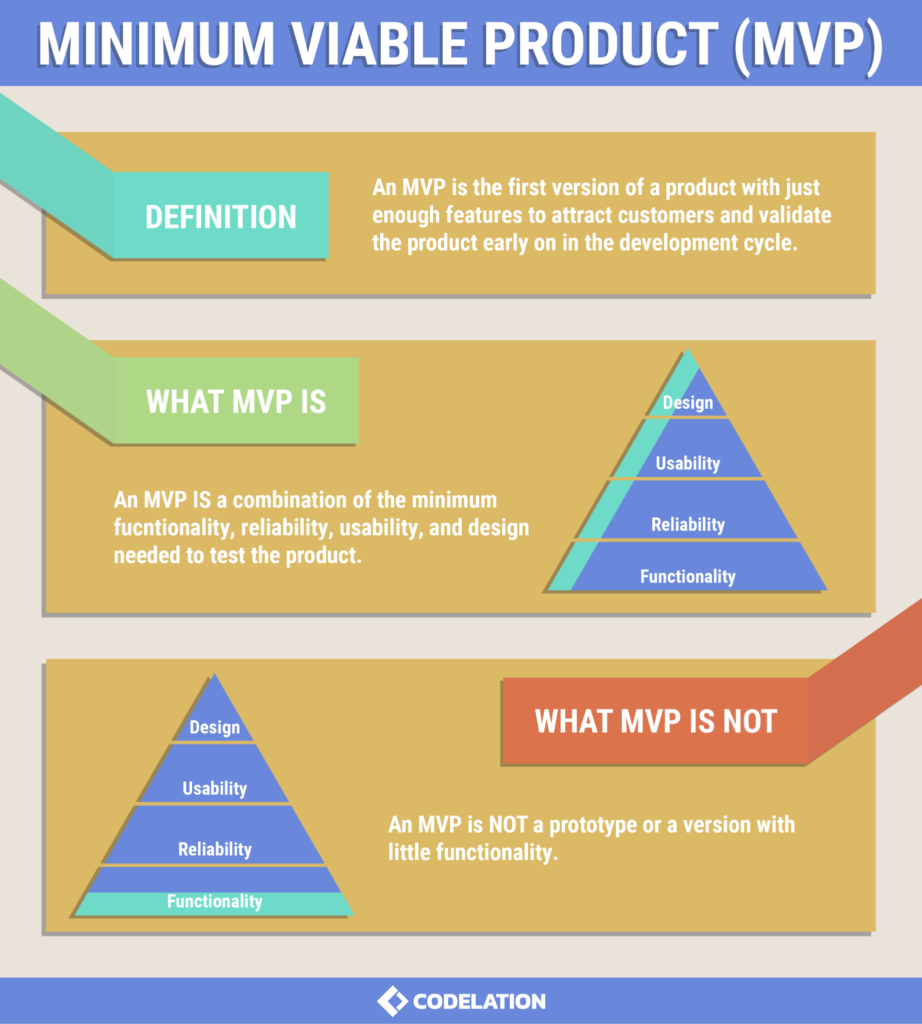
Budget
How Much Does it Cost to Build a Mobile App? In short, a lot, but we’ll give you the basics.
If you have a huge budget, you can probably hire a large development company that can churn out a product much faster than if you are limited to a smaller budget and can’t hire as big of a company to do your project. The amount of time it takes to build your app also comes down to how much billable time a company or developer has available in a week; they may have projects for other clients too.
Your budget will also affect how many developers you can work with at your chosen software development company. More developers leads to more work done in a shorter period of time, meaning your budget can completely change your timeline of completion. Having a bigger budget isn’t always the solution to faster delivery though. As we said before, big budgets typically come with big projects, and those take more time. The best thing you can do for yourself when developing a mobile app is hire the right company to be efficient and effective with your budget.
The best thing you can do for yourself when developing a mobile app is hire the right company to be efficient and effective with your budget.
Choosing the Right Development Team
Choosing the right development team and company affects how long your project will take, but it also highly affects your costs. While some larger companies may get the job done faster, the tradeoff is that they could cost more because their services are more expensive due to the amount of people they will dedicate to your project. On the other hand, a smaller company could take longer but could also be a more cost-effective option given the project timeline. While these scenarios might not be the case for every development company, you have to take into consideration that every company has different parameters such as price and availability. We suggest looking into several different development companies and choosing the one that fits your project's budget and timeline best.
To learn more about the development options for building a mobile app, click here.
Frameworks also play a part in choosing the right developer. A framework is a platform that gives developers a foundation on which to build software. Think of it as a template that can be altered to fit the client’s specific needs with customized code built by developers. In the case of mobile app development, there are frameworks that cater to the iOS platform, to Android, and some have cross-platform functionality.
Certain companies only use a few frameworks that they have grown to know and love. If you team up with a developer or development team, you'll want to keep in mind that they don’t have experience with every framework under the sun. If you decide you want your application built in a specific framework, you will have to shop around and see what potential partners use for building mobile applications.
Don’t know which framework your mobile app should be built on? Read Frameworks for Mobile App Development–5 Things Startup Founders Should Know here.
Planning & Preparation
Planning and preparation time should also be considered when thinking about how long building a mobile app could take. Here at Codelation, our discovery phase––which is where we do most of our planning––can take up to 3 months with some clients. The amount of time it takes to plan is very important because your developer won’t create anything without the approval of the product owner, so they need to make sure they’re meeting the standards of said owner.
Once again, we can't iterate enough how much the scope of your project affects the amount of time it takes to build an app. If you have a larger project with a bigger MVP, the planning stage is going to take longer and be more labor intensive. So if you’re hoping for a 6-month turnaround on the next Facebook, that’s not likely. Being sure to budget for planning time is key because your project probably won’t go straight into development as soon as you pitch the idea. You will need to do some market research and planning prior to the creation of your product, and the developer will have to do the same
Understanding the App Development Timeline
Agile vs. Waterfall Methodology
There are two main types of development that can also affect the time it takes to develop a mobile app. The first is Agile development. It is the more flexible of the two and our chosen method at Codelation. In this style, developers are able to continually prioritize the backlog of future tasks and sprint backlogs as needed when new challenges arise. This method also makes it easier for developers to fix problems that come up without messing with the overall project plan as much because they aren’t on as tight of a schedule. The one downside for the developer––which may be an upside for the product owner––is that there is a very high level of customer involvement using the Agile method. While this can be seen as an upside for the client, some developers won’t have time to be as involved with the client as others.
When using the Waterfall methodology for an app build, the whole project is laid out from the start with a full timeline and hard deadlines set at specific dates. Waterfall is used when the scope of a project is centered around a single plan or idea and doesn’t need to evolve or change as the project progresses. While this method is great for companies who need to meet quotas and deadlines, it doesn't allow for much flexibility or change. If a problem comes up during the app build that needs to be addressed, it’s difficult to fit new things in when there are previously set deadlines that don’t account for unexpected changes.
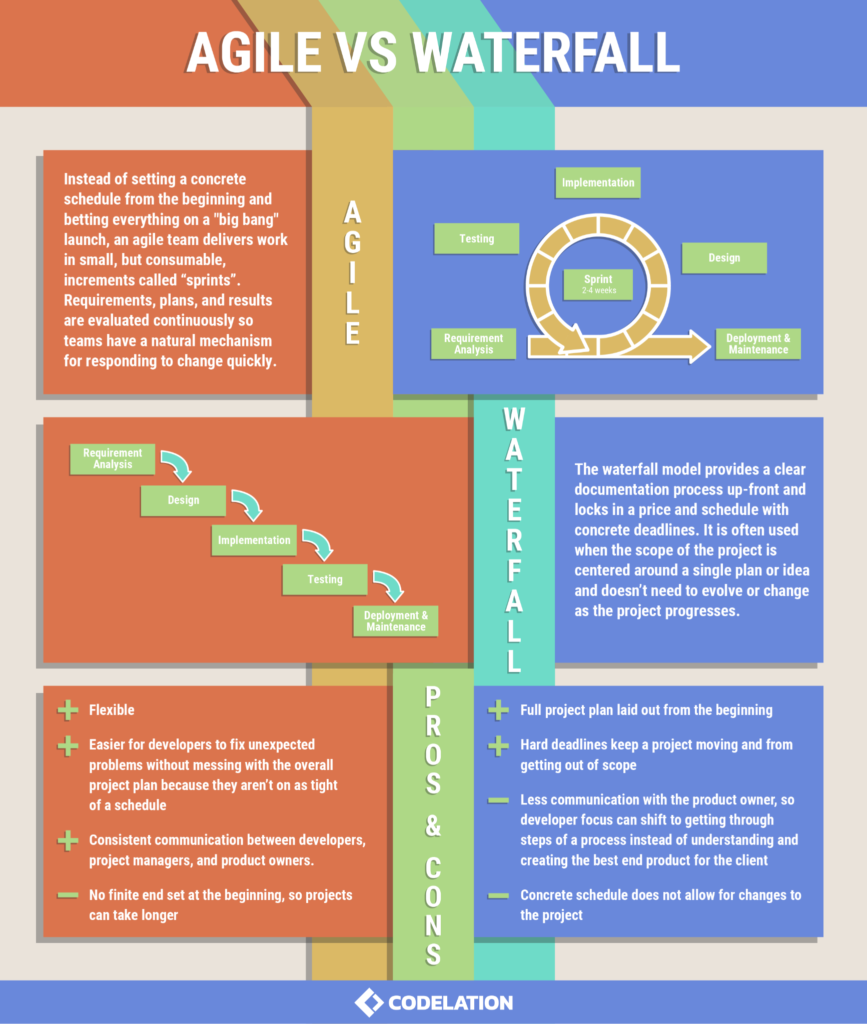
Stages of the Development Process
The Discovery Process
The app development process looks different for every client, but typically follows a similar pattern. First, an 11 step Discovery Process takes place where the development team works with the product owner to learn more about their goals and plans. The process is broken down in a way that allows developers to learn about a company, what they do, and how they can best help them with their project.
- Discovery Kickoff
The first step is the discovery kickoff where the client meets with the development team and talks about communication channels, budgets, timelines, and project overviews.
- Needs & Values Analysis
Second, a needs and values analysis takes place where the client gets to talk about all the things they would like to do with their project and all the features to backlog for a later time.
- Wireframing
After needs and values comes wireframing, where a UI/UX designer presents a mockup to the client with a potential layout and look of the user interface of the app or website.
- Define the Minimum Viable Product (MVP)
The fourth step is to define the minimum viable product (MVP) according to the client. They explain what the product needs to do and look like at its minimum level of design and functionality.
- Prioritize Backlog
Then, a project manager organizes the tasks and ideas developed in Step 2 into a backlog that prioritizes essential items over things that can be completed at a later time.
- Finalize & Present Wireframes
Once backlog prioritization is completed, the development team will present the client with final wireframes.
- Define Project Options
Together, they define the options for the project moving forward.
- Make Recommendations
Next, the development team will make recommendations for the client’s product based on the decisions they made in the previous step. The client can choose to take the recommended option from the development company or an alternate option.
- Develop a High-Level Roadmap
After that choice is made, they will be presented with a high-level roadmap that defines the schedule and timeline for the rest of the project. This can be adjusted by the client, but it is heavily based on what the developer can provide and in what fashion they can do it.
- Present Findings
Finally, the developer and project team present the findings and plan for the project.
- Finalize Decision
The last step of the discovery process is when the client finalizes the decision and gives the go ahead to move forward with the project.

The entire Discovery Process is just Step 1 in software development, but is very crucial because there is a lot of research, development, and decision making during this time. Without it, a development team would be going into a project without understanding a client’s wants and needs. This process can take anywhere from 1-4 months depending on the size and complexity of the project. It also can take longer if the recommendations in Step 8 are continually rejected and need revision because the client is unsatisfied with the wireframes. The Discovery phase is a crucial step in the development process because it’s only the foundation for what is to come.
The Production Phase
After the Discovery Process has been completed and the client has signed off on the plan, the production phase starts. In this stage of the development process, a project is divided into time frames called sprints which are 1-2 week periods where work is assigned to the development team to complete. This process starts when the backlog is prioritized, and tasks are compiled based on need and time constraints. They are then given to the project manager to determine who will be working on them.
Once work is assigned, the sprint starts. In addition to the developers, there is a quality assurance specialist who checks in at every step to ensure the programming for the mobile app has no issues, and everything works as planned. Every day, the entire project team will meet for 10-20 minutes to check in with each other and update the group on their progress. This meeting is called a scrum meeting. They prevent tasks from getting blocked, and in turn, work can continue to progress. The product owner is involved in every scrum meeting as this is how they get updates and stay in touch with the project.
After each sprint term is completed, the project manager goes and reviews the time spent versus the time estimate on each task and prepares to assign new tasks for the next sprint. They do this in order to accurately project the timeline and budget for the project and ensure work is staying on track. In the sprint meeting, the internal team talks about what went well and what didn’t during the previous sprint and what the upcoming tasks are. This process continues for as many sprints as it takes until the product is ready to launch to the general public.
Once a mobile app is ready to launch, the project goes through one last quality assurance check in its entirety, which usually takes a few days. After it passes that check, it goes to the product owner to be looked over one last time, and any last minute changes are made. Then, the app is launched, and it’s available for download on app stores or use online.
Continuous Improvements and Updates
After the app is out and released to the general public, the product owner can choose to go into a product maintenance and support phase. This shouldn't really be thought about as a phase however because this will continue as long as the app is out, as users are likely to uncover bugs or something may need to be changed that will require the app developers. During this time, new features can also be added or changed as the product owner sees fit.So, those are the main steps in the development process. As we said before, each step can vary on time depending on the size of the project, but the entire development process can be ballparked in the 6-12 month range depending on complexity. The process depends on a variety of factors like budget, time constraints, and the chosen developer.
Which Stages of Development Take the Longest?
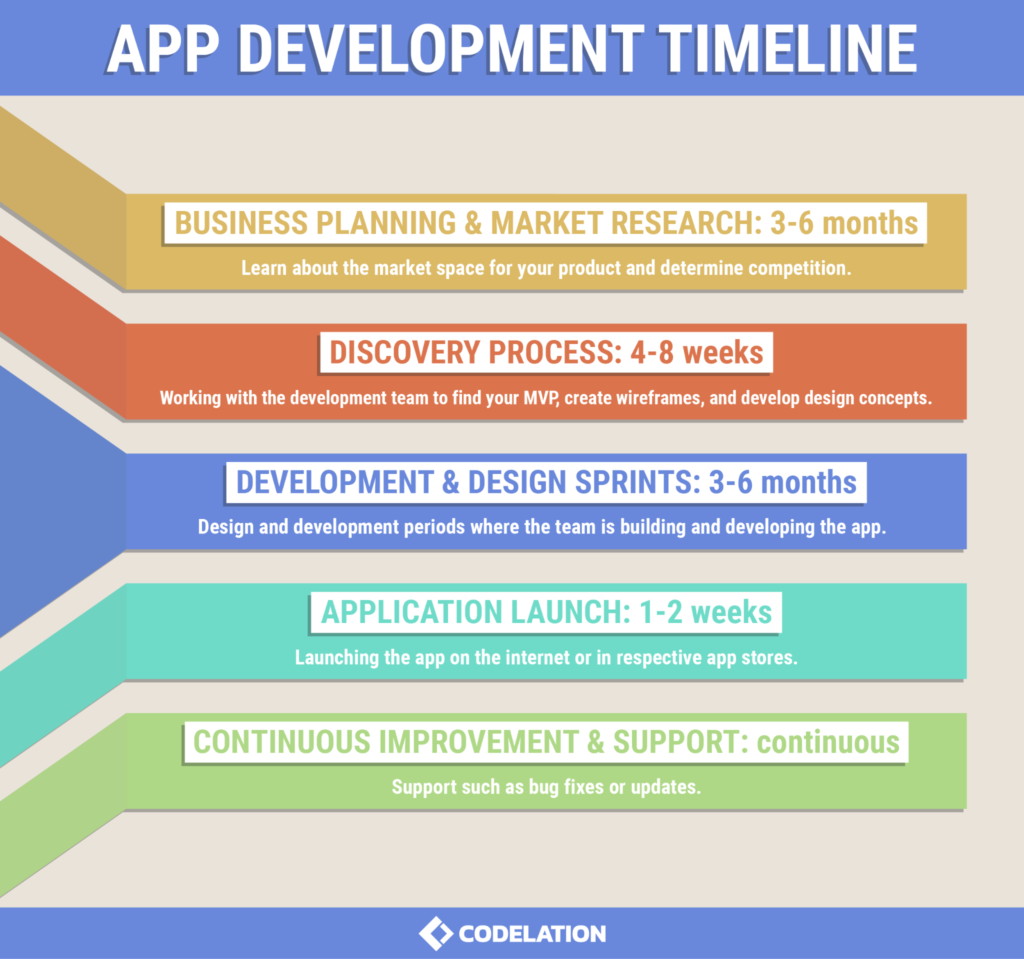
What Slows Down the Development Process?
The development process can vary in length depending on a variety of factors, the biggest of which is the complexity and depth of a project. If a project has 20 pages, each with their own content, buttons that lead to other pages, and links, the project will take longer. Another example of a complexity that could slow down the process would be if an app is used for online purchases and it needs to talk with bank accounts in order to have a secure checkout. All of this depends on the budget too, whether a product owner can pay for a large team with 10 people working on it 30 hours each week, or if they work with a smaller team that can only allocate 10 hours a week. The amount of money invested affects the time it takes because there are a limited number of developers and companies in the world, and they all come at a cost and all may have other projects to do as well.
What Can Product Owners Do to Make the App Development Process Run Smoothly and Quickly?
At the end of the day, it’s up to the product owner to decide how fast their product is developed, and typically it’s their goal to have it run smoothly and effectively. To make the development process easier, there are a few things they can do:
First, determine if the project is even worth pursuing by determining its validity. Do people actually want your product or service? Have you tested this idea out on your friends, and do they see value in it existing? Validation is a huge component to time and resources. If your product isn't worth creating, and you don’t have good feedback from people, then the time and money it will take to build your app will be completely wasted.
The second thing is market research, and asking if this product or service already exists. An important part of market research is looking for if someone has tried to solve your problem before. If yes, what happened to them? Also, understanding what the need is for your product and having a well established fan base or consumer group that wants your product will help ensure its success.
These are important questions to ask before even approaching a development company. Doing so will result in having to do less work in discovery because you know what you want more clearly, thus speeding up the development process.
In Summary...
In the end, the whole mobile app development process can take anywhere from 6-12 months, but that again can depend on factors like project scope, budget, and complexity, which can make it longer. To ensure that the project gets done in the most efficient way possible, it's important to do research in the field, understand costs, and find the right developer. Price and time standards will differ all across the board, but remember, the more complex a mobile app is, and the bigger the project, the longer it's going to take to develop. App development is a complex, ongoing process, and it’s going to evolve as the world of software development does.
Want to read more about the mobile app frameworks and costs of building a mobile app? Check out these articles: